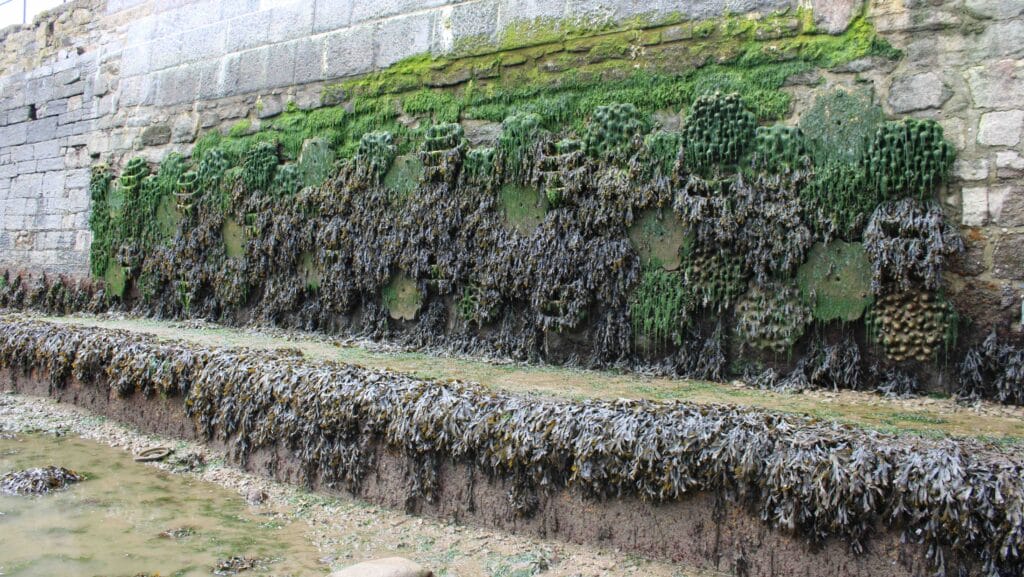
Eco-engineering the future of biodiversity with living sea walls

With biodiversity a major concern for the marine industry, there has been an increasing need to find innovative, eco-friendly solutions close to home where natural coastal habitats such as saltmarshes, mudflats and beaches are routinely giving way to artificial structures including seawalls, marinas and pontoons.
Ports and harbours may not be the first places to spring to mind for creating ecologically enhanced environments but PhD student Jess Allen from the University of Plymouth is demonstrating how vast swathes of grey concrete structures that form the foundations of many of the ports and harbours can be harnessed to recreate natural habitats. These habitats can promote and sustain marine life, while still providing their initial civil engineering function.
“Ecological engineering is a way of encouraging biodiversity back onto our artificial coastlines,” says Allen, who is undertaking her PhD project on the multi-functionality and effectiveness of coastal eco-engineering solutions.
“When used effectively, eco-engineering can bridge the gap between our human requirements of the coast and the requirements of our local ecosystems.”
In busy ports, mini-environmental ‘disasters’ often take place. Those come from damage caused by anchors being dragged across the seabed, oil slicks, engine emissions and grey water discharge from boats’ sinks and showers containing plastic microbeads and other toxic elements. They all add to the hotbed of chemicals and waste that disrupts the fragile ecosystems beneath the surface.
Allen aims to demonstrate the potential of eco-engineering solutions to transform artificial coastlines into thriving marine habitats, providing value to both society and the marine environment.
There are already numerous conservation projects around the globe looking at coastal preservation; from oyster reefs in New York and mangrove replanting in Ecuador to seabins in the Mediterranean, all helping to address the delicate balance between the anthropogenic and natural world.
Living Seawalls’ modular panels can be fixed retrospectively
One of the organisations looking at science-based solutions to tackle biodiversity loss in coastal regions is Living Seawalls, a Sydney-based company that produces modular panels that mimic foreshore and intertidal habitats and can be fixed to harbour walls and marinas.
“Living Seawalls have been shown to transform structures along our coastlines, turning flat, lifeless walls into havens of biodiversity, by combining decades of ecological and engineering knowledge,” Allen says.
Each modular panel is designed to create a bespoke habitat for different marine life, such as the rock pool panel that retains a small puddle of water for species that need to remain submerged at low tide.
After learning about Living Seawalls, Tina Robinson from the ocean conservation charity Our Only World recognised their immediate potential for UK application and, with Louise Firth, former associate professor of marine ecology at the University of Plymouth, initiated the ‘Living Seawalls in Plymouth’ project.

Sutton Harbour project for Living Seawalls in Plymouth
In 2023, a team of researchers and marine engineers from the university, working in partnership with local organisations and funders, created a Living Seawall, by installing modular panels on a seawall in Sutton Harbour, Plymouth.
The build work lasted two weeks. It took place over multiple low tides and by the time it was completed the first panels had already formed biofilm – a layer of micro-organisms that stick to wet surfaces and help additional species establish themselves onto the surface of the panels. Algae soon followed which attracted more marine species that are now flourishing.
Firth (who is now senior lecturer in environmental sustainability at University College Cork) explains that the purpose of Living Seawalls is: “basically to make space for nature on a structure that it wouldn’t normally survive on.”
Furthermore, the habitat-enhancing panels actively bolster biodiversity which then attracts bivalves such as oysters and mussels. These molluscs are widely known for their incredible water purifying capabilities. One mussel can filter up to 150 litres of water per day, with a single oyster filtering nearly 200 litres a day, helping to remove harmful pollutants from the sea.
Having already won a slew of awards for design, innovation and biodiversity – as well as being a finalist in Prince William’s coveted Earthshot prize in 2021 – Living Seawalls represents a paradigm shift in coastal protection, actively reviving marine habitats by creating a haven for seaweeds, invertebrates, small fish and other marine fauna.
Within just 1-2 years, Living Seawalls’ research suggests, modular panels increase biodiversity by up to 36 per cent compared with plain, unmodified seawalls, similar to natural rocky reefs, which are known hotspots of biodiversity.
Eco-engineered seawalls made from recycled marine-grade concrete
Adding another sustainable win to this story, in the UK and Ireland the panels are made from recycled marine-grade concrete from pontoon manufacturer Inland and Coastal Marina Systems (ICMS).
By repurposing industry waste into construction material for Living Seawalls, ICMS not only reduces its ecological footprint but also demonstrates a commitment to circular economy principles. This eco-friendly approach is a testament to the company’s dedication to sustainability at every stage of the production cycle.
“As part of our sustainability initiative, we’re always looking at ways to minimise the impact of our business and the products we produce on the environment, and the partnership with Living Seawalls provides us with a dual-purpose solution,” says Oliver Shortall, ICMS’ MD.
The post Eco-engineering the future of biodiversity with living sea walls appeared first on Marine Industry News.
